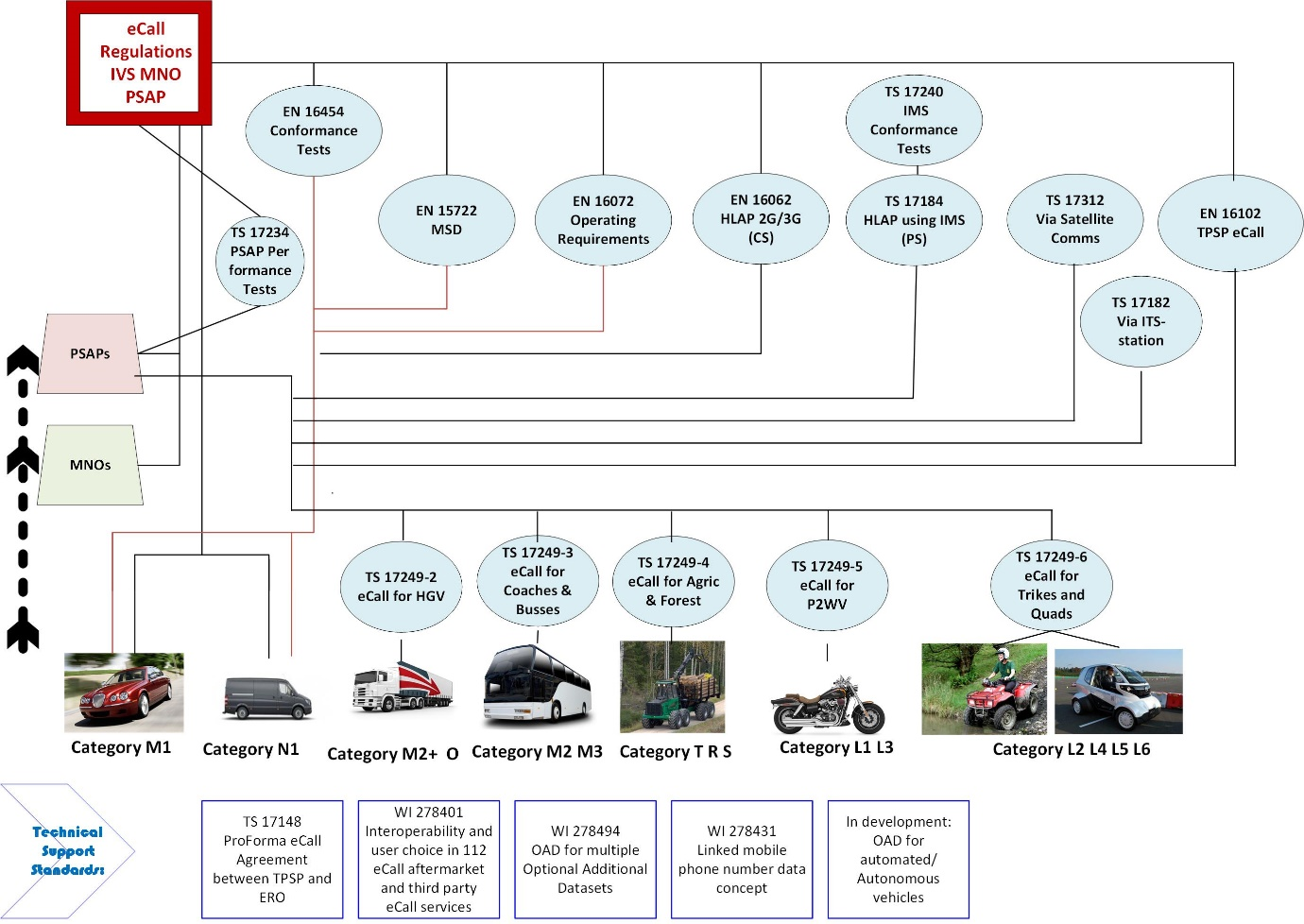The remit of WG15 is “eSafety”, i.e. to develop standards deliverables which use Intelligent Transport Systems to increase the safety of users of road transport systems. During its first decade of work, the focus of the work of WG15 has been on eCall.
This working group was established in 2016. WG15 currently comprises about 80 members plus 5 document monitors, from 18 CEN countries. As at October 2018 it had about 25 work items.
WG15 is also providing specifications for messaging and data formats between the emergency responders and other sources of key information, and to enable the forwarding of eCall data, and indeed the eCalls themselves, along the rescue chain. All of these provisions are important, but are fitted only to ‘new model’ vehicles (since April 2018). The focus of WG15 now turns to minimum requirements for aftermarket devices, so that the 300+ million vehicles, of all categories, already on Europe’s roads today (expected to be closer to 400 million by 2025), can all receive the benefits of eCall.
When vehicles crash lives are at risk. Every minute counts. The faster that those injured receive medical attention the better. Fewer will die, and the long-term effects of injuries will be less severe. The consequential disruption to traffic can be minimised. But it will not happen by chance and innovation alone.
Since April 2018 all new model cars and light vans in Europe are required by law to be equipped with 112-eCall (although they may also use third party service provider eCall).
Without compromising the privacy of the vehicle occupants in normal driving conditions, in the event of a serious crash (and only in the event of a serious crash), the 112-eCall system in the vehicle contacts the 112 emergency services, establishes a wireless telephone connection and immediately provides the ‘public service answering point’ (PSAP) with a ‘minimum set of data’ that identifies the vehicle, location of the crash, direction of travel, and may provide additional relevant data (such as the number of seat belts closed at the time of the crash). The emergency services can then talk directly with the occupants of the vehicle. Of course, this has to be undertaken consistently, and CEN Standards underpin, and are referenced by, the European eCall Regulations for Category M1 and N1 vehicles. CEN TC278 WG15 ITS – eSafety, is the focus and driving point for the development of standards to support the eCall paradigm.
A 112-eCall is technically defined as a ‘112 emergency call with data’ and is given priority on the network and automatically connected to the most appropriate PSAP by the mobile network operator (MNO). As soon as the call is established, the audio systems in the vehicle are muted and the vehicle transmits a ‘Minimum Set of Data) (MSD) to the PSAP. This data provides the vehicle identification, location, and direction of travel immediately before the incident. It may also provide the number of passengers, and other vehicle and incident related (non-personal) data. The system then reconnects the vehicle internal audio systems and the PSAP can talk directly to the occupants of the vehicle. CEN Standards underpin the behaviour required by the in-vehicle system, the MNO service, and the PSAP service, and are directly referenced by the European Regulation to determine the requirements on the actors involved.
The “minimum set of data” is defined in EN 15722. The requirements for 112-eCall are defined in EN 16072. The application protocols to make an eCall using 2G/3G mobile telephony are defined in EN 16072 (referencing ETSI 3GPP Release 8), and for 4G/5G in CEN TS 17184 (refrencing ETSI 3GPP Release 14). Specifications are also defined for making an eCall via satellite communications (CEN TS 17312) and from a C-ITS equipped vehicle (CEN TS 17182).
A raft of standards deliverables support these core specifications and are providing conformance tests, and standardise the information exchanged with and between emergency responders.
Third party service providers (such as car manufacturers, car clubs, insurance providers, etc.) are also allowed to provide ‘Third Party Service Provider’ variants of eCall (so long as the vehicle user can revert to 112-eCall at any time he/she chooses, or whenever the third party system is not operational), and EN 16102 ensures that the information provided to assistance providers is consistent with that for 112-eCall, and provides specifications for the assistance provider to talk with the occupants of the vehicle
At the moment the eCall Regulations only cover ‘new model’ cars and light vans (Categories M1/N1). But motorcycles, though representing only about 2% of traffic in Europe, account for about 20% of deaths and serious injuries. Heavy Goods Vehicles represent only 5% of traffic but account for 13% of deaths and serious injuries. Furthermore, loads that are shed during crashes cause disproportionate traffic chaos and delays. The number of tractors are few, but when they crash they are usually in a remote place with no witnesses and the driver is alone. When coaches and buses crash, they are usually full of people, so the crash immediately becomes a major incident. So WG15 has turned its attention to expanding eCall to cover all categories of vehicle, and the CEN 17249 series (Parts 1 -6) provide specifications to enable this, and CEN TS 16405 provides a way for the PSAP to quickly establish the load being carried by a commercial vehicle.

European Standardization In Support Of eCall